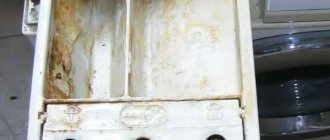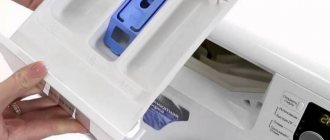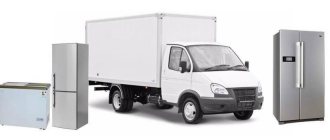How to transport a washing machine correctly
Any person at least once in his life has experienced all the delights of moving, which involves transporting a variety of things and furniture. Faced with the problematic issue of transporting household appliances, many ask the same question - is it possible to transport an automatic washing machine in an unauthorized position, how to pack it, is it necessary to use bolts, etc. Let's try to understand the intricacies of transporting AGRs together.
Features of transporting vehicles with vertical loading
Above we described the process of preparing, carrying, loading and transporting a front-loading automatic washing machine. There is only one peculiarity of transporting machines with vertical loading - you only have to fix the loading hatch (the machine does not have a separate cuvette for detergent, the powder receptacle is built into the hatch or is absent altogether - as, for example, in a semi-automatic machine).
If you do not follow the rules for preparing and transporting the washing machine:
- The integrity of the power cable is damaged.
- Parts of the body made of plastic become deformed and break off.
- The cuff breaks and the loading hatch fasteners break.
- Hoses and pipes are torn.
- Electrical wiring and contacts get wet and short out.
- The control panel toggle switch breaks off.
- The drain pump becomes unusable.
- The loose detergent dispenser breaks off.
The process of transporting a top-loading and front-loading washing machine by specialists in Novosibirsk does not take much time compared to trying to do it yourself. Negligence and inattention of handicraft workers will lead to damage to the integrity of the housing and malfunction of the electronics. In this case, the funds saved on transportation by a specialized company will be used for repairs, or in the worst case, the purchase of new household appliances. Remember that “the miser pays twice”!
We prepare the unit for moving
Before loading the machine into a vehicle, it must be protected with factory-made packaging material. When this is not available, you will need additional protection from foam pads, foam sheets, and soft blankets. Such options are considered more successful. Considering the fact that the factory box of the machine is stored for no more than the warranty period, then it is simply thrown away, you will have to use available options. In addition, the machine will have to be securely fixed so that it does not get damaged.
Transport the laundry washing unit as follows:
The washing machine is ready for transportation. All that remains is to securely fasten it in the body, making it impossible to move.
Many experts agree that the best option for transporting a laundry washing machine is in a vertical (standing) position. You just have to securely fasten the drum. Loading onto the vehicle body must be carried out vertically. If you have large items, it is recommended to install the machine tightly among them. During transportation, the unit must not be turned upside down. This is an exceptional case for new devices that do not contain a drop of moisture.
Preparing the washing machine for transportation
Before placing the washing machine in the car, you need to pack it properly. The ideal option is to use a factory box specifically designed for this purpose. But since the “original” packaging, as a rule, is not preserved for a long time, you should pack the machine using improvised means.
The preparation of the machine is carried out in several stages:
- Disconnecting the unit from the power supply, water supply and sewerage.
- Draining the liquid remaining after washing. It is very important to remove all the water and wait a while for everything inside to dry. This is necessary to prevent moisture from entering the unit’s electronics.
- Securing wires and hoses for ease and safety of movement.
- Sealing corners and traumatic elements with tape.
- Secure the drum with transport bolts. If they are lost over time, you will have to secure the drum in another way - remove the back cover and place some materials, such as foam rubber or rags, in the opening between the wall and the tank, then attach the panel back. This will mitigate vibrations during transportation.
- Housing protection is another important consideration. If there is no original packaging, it is enough to wrap the machine in cloth, cardboard, polyethylene or something else, tying it with a rope on top.
When these manipulations are completed, you can begin transportation, but here there are also rules that cannot be avoided.
Is it possible to transport the machine without bolts?
Rarely does anyone remember about transportation bolts, because many people lose them soon after purchasing the machine. And if this happens, you will have to look for alternative options.
Washing equipment is often transported without such fasteners. In this case, it is necessary to remove the top panel to immobilize the elements inside.
After removing the body, arrange the gasket. It is not recommended to use hard elements - only foam rubber, rags or polystyrene foam.
Having filled the free space, screw the lid into place. Once the tank is immobile, protect the side walls. For this purpose, the body is wrapped in fabric and secured with cord.
Now you don’t have to worry about the safety of your equipment - everything will be delivered without damage.
Preparation of equipment
An important step in this difficult task is preparation. Recommendations vary depending on whether there are shipping bolts or not.
A few rules that will be needed during transportation:
- At least a day before moving, you should stop using the washing machine. Open the hole for clothes and powder. This way the equipment can dry out and nothing will spill out of it into the car during transportation. You also need to remove the cord from the outlet. If you cannot avoid using the device, you should wipe it inside.
- Use a dry cloth to remove dirt and dust from your equipment.
- If the hoses are removed, then it is better to do so. If not, then they need to be dried so that no water spills out. Secure the hoses. This way they won't interfere.
- Cover all corners with tape.
Next we move on to fixing the drum.
With transport bolts
It is not difficult to guess that if there are transport bolts, then the task is much simpler. To do this, you need to install bolts on the back of the unit. Modern washing machines have “plugs” that help securely fix the equipment. They must first be removed. But under no circumstances should you throw them away, as they will come in handy when the bolts are pulled back out.
After the equipment takes its new place, the transport bolts are removed. If you ignore this point, the washing machine will be damaged.
How to transport a washing machine without shipping bolts
Some owners panic and discover that there are no shipping bolts. Perhaps they were lost or were not included at all. Panic immediately begins, what to do? But there is no need to worry. There is a way out of this situation. You can transport the washing machine without transport bolts. True, you will have to work a little to carry out such cargo transportation competently and without consequences.
First, you need to properly fix the drum so that it does not spin in different directions during transportation. This can be done in different ways:
- Option No. 1: Place foam plastic in the hole separating the drum and the walls of the machine. This should be done tightly to securely fasten the drum. In this case, there is a significant disadvantage: polystyrene foam tends to crumble. Therefore, this thing is unreliable and can fail at the most inopportune moment. But there is good news: polystyrene foam will not harm the washing machine in any way.
- Option #2: Use rags instead of polystyrene foam. You will need a few unnecessary rags. The bigger, the better. The fabric should be soft. It is placed in the same hole as the foam. But in this case, the rags will not crumble and fall apart. Therefore, this method is more reliable.
- Option No. 3: The recommendation is suitable for washing machines in which the hole between the drum and the wall of the machine is insignificant. You need to unscrew the back cover and fill the space with foam or rags. This method has pros and cons. Plus: reliability. Minus: removing the cover without damaging anything is quite difficult.
Remember that if there are no shipping bolts, there is no need to use homemade ones. In this case, some resort to self-tapping screws. This is absolutely not worth doing, as you are more likely to damage the device. If the question arises of how to transport a washing machine without transport bolts, then there is no need to resort to DIY. You can contact the specialists of the transport company.
Is the washing machine transported lying down?
There are standard requirements for transporting a washing machine, which are necessarily listed in the instruction manual. The following conditions of carriage are stated there:
Naturally, every rule has its exceptions, which are determined by life situations. In such cases, you have to find the right way out so as not to damage the equipment. But remember that all violations of the instructions are fraught with consequences and will remain on the owner’s conscience.
In exceptional cases, it is allowed to transport the device lying down (on its side). The floor in the body is first lined with soft material or foam rubber. The machine is placed “on its back”, the sides with the drum and panel should remain on top. For the machine, the position “along” is determined in relation to the movement of the vehicle.
Some subtleties of transportation
Remember that the machine must not be turned over. It is better to carry her on her side or on her back than upside down. A certain amount of water will definitely remain inside, which can flow onto the panel responsible for general control. Repair work will be expensive in this case, so it is best to dry the machine thoroughly.
By the way, moisture can accumulate in the detergent tray. It is recommended to remove it and transport it separately from the main device. If this is not possible, wipe it with a dry cloth.
Remember that you can put all models and brands of cars on the back wall, except Zanussi. It is in it that the weighted counterweight elements are located so that in the given position “on the back” they are capable of damaging the valve responsible for water intake.
Definitely do not place the machine on the front wall. During transportation you will damage the loading hatch and rubber seal.
Features of transporting vehicles with vertical loading
Above we described the process of preparing, carrying, loading and transporting a front-loading automatic washing machine. There is only one peculiarity of transporting machines with vertical loading - you only have to fix the loading hatch (the machine does not have a separate cuvette for detergent, the powder receptacle is built into the hatch or is absent altogether - as, for example, in a semi-automatic machine).
If you do not follow the rules for preparing and transporting the washing machine:
- The integrity of the power cable is damaged.
- Parts of the body made of plastic become deformed and break off.
- The cuff breaks and the loading hatch fasteners break.
- Hoses and pipes are torn.
- Electrical wiring and contacts get wet and short out.
- The control panel toggle switch breaks off.
- The drain pump becomes unusable.
- The loose detergent dispenser breaks off.
The process of transporting a top-loading and front-loading washing machine by specialists in Novosibirsk does not take much time compared to trying to do it yourself. Negligence and inattention of handicraft workers will lead to damage to the integrity of the housing and malfunction of the electronics. In this case, the funds saved on transportation by a specialized company will be used for repairs, or in the worst case, the purchase of new household appliances. Remember that “the miser pays twice”!
Transporting large household appliances, which includes a washing machine, is a separate topic for discussion. Regardless of whether you are buying new or transporting an item when moving, you must comply with the manufacturer's requirements. There are no problems when transporting new equipment in its “original” packaging - just follow the markings on the box.
Things are more complicated with a machine that is in use. Ideally, the equipment is placed in the original packaging, and foam is placed in the wall. However, buyers usually store the packaging for 14 days, and then dispose of it like any other household waste. Instructions, components and fasteners are rarely preserved. What remains is a “lonely” washing machine, the transportation of which will have to be improvised.
The process of transporting a washing machine by loaders in Novosibirsk begins with preparatory work:
- Dismantling is carried out: the machine is disconnected from the electrical network and water supply (first the water is turned off, only then the hose is disconnected).
- Remaining water is removed from hoses, pipes, drain pump, and drum. If this is not done, unpleasant situations may arise when moving the machine.
- The door (loading hatch) and the detergent cuvette are fixed with adhesive tape or masking tape, wires and hoses are secured with plastic clamps.
- Cover sharp corners and protrusions with masking tape, which can cause injury or damage to surrounding things (furniture, walls, doors) when carrying the machine.
- The tank is secured with transport bolts. They are screwed through holes in the back wall of the machine.
- The body of the machine is wrapped in corrugated cardboard, stretch film or fabric (you can use: blankets, bedspreads, blankets, sheets), and tied with twine.
What are the consequences of violating transportation rules?
Without studying the established rules, SMA owners quite often cause significant damage to the equipment during its transportation. Even a short trip of no more than fifteen minutes can result in complete failure of the device.
What can happen if transportation is disrupted:
Each of the breakdowns is eliminated, except for the damaged housing part or the complete loss of functionality of the electrical unit. Connecting the machine for testing is permitted after it has been completely unpacked and the bolts securing the drum have been removed. It is likely that they may be needed someday. The best storage option is in a plastic bag secured with tape on the back wall of the washing machine.
The machine should be installed in the designated place after the levelness of the floor has been checked. If this requirement is neglected, then during operation the unit may leak or “refuse” to perform the specified function.
To prevent anything like this from happening, the machine must be carefully prepared for the upcoming move and its movements from the bathroom to the new destination must be carefully monitored.
Transporting a new unit
The cars are transported for the first time during purchase from the store to the apartment. Many people solve the problem simply - they buy the product and have it delivered to their doorstep. The device is packaged in a factory box and has reliable protection against negative effects. This option is convenient and is used by many retail stores as a free service if an expensive model is purchased.
Not only is there no need to look for a car and people for loading, but all responsibility for the integrity of the goods lies with the supplier, which in our case is the store. However, after delivery, it is recommended to check the device immediately - inspect the integrity of the packaging, completeness, and make sure there is no damage.
Expert advice
If the machine needs to be lowered from a multi-story building, you will have to try not to turn it over. Knowledgeable people assure that the device descends only in a vertical state, only slight inclinations are allowed. Such carrying is impossible for one person, so several people will be required for such an operation. The fact is that during careless carrying or installation the machine can be easily damaged.
It is not recommended to drag the washing machine around. There is a possibility of not only damage to the floor covering, but also to the body of the unit. The shape of the machine is streamlined, there are no additional handles for carrying, so you will have to tilt it a little whenever you move it. Before performing such “maneuvers,” it is better to enlist the help of another person who will secure the device from the opposite side.
If you don't have bolts to secure the drum, you can purchase them at a hardware store.
Is it possible to transport a washing machine lying down?
Transporting a washing machine and other large household appliances involves various difficulties. If you have just purchased such a product, then use the store’s delivery service. But what should you do if you need to move the washing machine when moving or send a household appliance to the country? We will talk about this in this article.
Transport without transport bolts
If the transported bolts have not been preserved, the upper wall of the device is removed, the space between the walls and the tank is filled with foam rubber, polystyrene foam, or anything with a fabric base (some people use kitchen sponges for dishes, pieces of old padding polyester blankets). After fixing the tank, the top wall is returned to its place and secured.
Before using improvised means, visit the nearest hardware store and purchase transported bolts - this way you are guaranteed to protect the washing machine from possible damage during road rolling.
Are safety bolts required during transport?
After purchasing a washing machine, it will be delivered to you using safety bolts. They protect the drum from loosening during transportation. If such bolts are safely lost, then you can transport the “washing machine” without them.
But it's not that simple. To prevent moving parts from moving inside the washing machine, you need to open its lid and secure all moving parts. To do this, you can use foam rubber and other materials that will prevent parts from becoming loose. When securing the drum, everything must be done to eliminate the risk of damage. The lid can be closed and the appliance can be moved into the van.
What are transport bolts for washing machines?
Initially, when releasing a home laundry assistant, manufacturers provide specialized transport bolts that are designed to fix the tank and prevent possible damage during transportation of the unit.
Fixing the tank is necessary, since it is the main moving unit in the car, which can damage other mechanisms inside when shaking in the car during transportation.
Answering the question of why shipping bolts are needed, we can say that they act as fasteners that do not allow the tank to move, which means you can rest assured about the other components in the machine.
Many owners of household appliances, in particular automatic machines, do not know how to remove the shipping bolts on a washing machine, since when it is delivered, technicians often unscrew the fastenings themselves, and the owners remove these bolts far away and completely forget about their purpose.
If you don't know what shipping fasteners look like, just think of regular six-point bolts. These fasteners are supplied with metal washers and plastic plugs.
How to transport a washing machine?
The best option is to transport the washing machine by special service employees who transport personal belongings. Specialists with extensive experience know how to properly pack, load and secure a washing machine in a car. If you do not want to spend your money, you can use personal transport. Well, you need to understand that a passenger car is not suitable for such transportation. And loading and unloading can only be done together with someone else. It will be difficult for one person to carry out such work.
There are two options for transporting the washing machine: vertically or on the back wall. This household appliance cannot be transported on the front wall or top cover.
The best option is to carry it in a standing position. But this is not always possible. If the “washing machine” can only be placed lying down, then cover the area and place the unit on its back. Secure the machine so that it does not move while moving.
Source
Twist and turn: rules for transporting a washing machine
A washing machine is a large and heavy appliance. Given the significant dimensions and weight of the equipment, at least two strong men must carry and load it into a vehicle. When lowering the washing machine down to the car, it is not recommended to turn the body over. For convenience, you can tilt the device slightly backwards. Not only a truck, but also a passenger car is suitable for transporting the unit. In the first case, the product will ride in a natural position - standing. The method of transportation in a passenger car depends on its characteristics. The following options may be considered:
- standing;
- on the side wall;
- on the back panel.
The best option is a vertical position. In this situation, the risk of damage to the washing machine is minimal. The equipment is deployed in the car body sideways in the direction of its movement. In addition, you can transport the washing machine lying down. Be sure to throw foam rubber or a layer of fabric on the floor, only then lay the device on the back panel. The soft layer will serve as a kind of shock absorber and absorb vibrations on bumps. Transporting a washing machine on its side has its own nuances. You cannot position the equipment so that the powder compartment is on top - any remaining moisture from it can damage the electronic “stuffing” of the device. The position on its side is quite unstable, so the machine needs to be fixed. Ropes are suitable for fastening; you can cover the equipment with other large things.
No matter how carefully you prepare for transportation, choose a safe speed limit when driving the vehicle. Many people do not comply with the listed transportation rules, so after the trip the car is sent to a service center or to a landfill. One wrong move - the plastic parts of the device break, hoses break, and electronic equipment fails. If you do not have confidence in your own abilities, it is better to entrust the procedure to professionals. And don’t forget to remove the shipping bolts upon arrival or remove the insulator that was used to cover the drum.
Back to Contents
How to transport a washing machine
It may be necessary to transport a washing machine in several cases. The first is purchasing a new unit in a store. The second is moving from one apartment to another. And the third is the sale/purchase of a used washing machine with pick-up. In the first case, the buyer practically does not care about delivery of the goods to his home. Most often, this is done by store employees. The new machine is transported in special original packaging, reinforced with shock-absorbing materials, so complete safety of the contents is guaranteed. But if the device has already been working for some time, the question arises of how to transport a washing machine without packaging correctly, so as not to damage its mechanisms.
Protect it like the apple of your eye, or How to securely fix the drum?
The drum of a washing machine is one of the most important and fragile mechanisms. When hitting a bump, an unfixed structural element will damage other parts of household appliances. The unit is supplied with transport bolts from the factory. They are installed on the back of the machine and help securely fix the drum.
Such small details are often lost over time. Therefore, the question arises along the way: how to transport a washing machine without transport bolts? In such a situation, the drum is immobilized using available means. The work is quite easy:
- Unscrew the bolts and remove the top cover of the unit.
- Fill the space between the tank and the walls with unnecessary rags, foam rubber, and polystyrene foam.
- Check that the drum is stationary.
- Reinstall the top of the machine.
After completing this operation, you should start packing household appliances. It’s good if the factory box has been preserved, then the free areas inside are simply lined with polystyrene foam. But more often, owners throw away cardboard containers immediately after installing the washing machine. Knowing the packaging rules, you can maintain the presentation of the equipment even without the original box. The sharp corners of the washing machine are covered with cardboard and covered with tape. The product itself is wrapped in fabric and tied with ropes. The main task of the preparatory stage is to ensure reliable protection of the components of the equipment from vibrations that can damage it.
Back to Contents
How to prepare a washing machine when moving
The preparation process begins by unplugging the machine and disconnecting the drain hose. Even if you have not used the device for a long time, some water always remains inside the hose and pipes. Drain the hose after disconnecting it and leave the holes open to dry. The less moisture remains in the machine, the less you risk causing flooding of the mechanisms. Carefully roll up the power cord and hose; it is advisable to pack them separately.
Purpose of the preparatory stage
— protect all components as much as possible from vibrations, which have a detrimental effect on them. Manufacturers provide for the possibility of subsequent transportation of the washing machine, so they complete the products at the factory with shipping bolts. They are sold complete with units with both vertical and horizontal loading. Shipping bolts fix the drum in one position, so the insides of the machine remain intact. Simply screw the bolts into the special holes on the back panel.
Thorough preparation is the basis for safe transportation
When purchasing a new washing machine, there are no problems with transportation. The equipment is reliably protected by the original packaging, so when loading and moving the car you don’t have to worry about the integrity of the unit. Difficulties have to be encountered when transporting equipment that has been in use. The owner has long ago gotten rid of the box in which the machine was sold, and the shipping bolts are irretrievably lost. In order for the equipment to reach its destination without damage, you will have to carefully prepare for the trip. The procedure is as follows:
- The washing machine should be disconnected from the power supply and the water supply hoses should be disconnected.
- The equipment must be thoroughly dried. Lower the water drain hose below the pan of the machine - this will help remove the remaining liquid. Leave the valves open for a while to allow the moisture to completely evaporate.
- Carefully twist the wires and hoses and wrap them in plastic. Use tape to secure the powder compartment.
Offers its assistance in transporting the washing machine. A specially equipped truck and a team of experienced movers are provided to clients. The team knows all the intricacies of handling equipment, so transportation will take place as quickly and safely as possible. The company has set affordable prices for services. Entrust the solution to the problem to professionals - do not risk your “assistant”.
Back to Contents
How to transport a washing machine without shipping bolts
However, transportation bolts are often lost or not passed down “inheritedly” after purchasing a used unit. In this case, you need to ensure the tank remains stationary using available means. Unscrew the fastenings of the top panel of the machine, insulate the drum with rags, bubble wrap or similar soft materials, and then screw the panel into place.
Once you have secured the drum, you can begin the final stage of packaging.
In order to pack the washing machine, you need to stock up on:
Wrap bubble wrap or rags around the electrical cord and drain hose. Secure the machine hatch and powder cuvette with tape. Carefully wrap the unit with stretch film and cover it with foam plastic or corrugated cardboard, wrap the packaging tightly. If you don't have corrugated cardboard or polystyrene foam on hand, you can make do with an old blanket. You will also need to place a blanket on the bottom of the car under the washer.
Transport without transport bolts
If the transported bolts have not been preserved, the upper wall of the device is removed, the space between the walls and the tank is filled with foam rubber, polystyrene foam, or anything with a fabric base (some people use kitchen sponges for dishes, pieces of old padding polyester blankets). After fixing the tank, the top wall is returned to its place and secured.
Before using improvised means, visit the nearest hardware store and purchase transported bolts - this way you are guaranteed to protect the washing machine from possible damage during road rolling.
How to demolish a washing machine and load it onto a car
A washing machine is not an easy device. In order to move it from place to place, the strength of two strong men will be needed. And some manufacturers, for example Miele, produce units whose weight is 100 kg or more; they can only be lifted by three people.
You can only take the washing machine out of the apartment directly, without turning it over. Only a slight bend back is allowed. If there is no elevator at the entrance, then you simply cannot do without professionals. It is better to move and move the washing machine with movers who have the relevant experience and the necessary equipment for this.
An important part of the process is loading the unit. Manufacturers indicate in the instructions how you can transport the washing machine without the risk of damage - “standing up”. Accordingly, a passenger car is not suitable for such tasks. It is better to load the unit sideways in the direction of movement. If you are transporting other things along with the washing machine, then bundles and bags with clothes and bedding will only help - they can be placed around the machine for additional shock absorption.
Transportation methods
Transportation is the most critical stage, which should be given maximum attention. There are several acceptable ways to move the machine:
- Vertically (standing) is the main and most correct way of transportation.
- On the back wall (except for Zanussi machines) - this method is acceptable if the washing machine is transported in a passenger car, or for other reasons it is not possible to place it vertically.
- It is extremely undesirable to transport the machine on its side, since this method is accompanied by a high risk of malfunctions.
In all cases, it is advisable to place the machine sideways in the direction of movement, and also press it well with other things.
Throughout the entire journey, the driver must monitor his speed and try not to hit potholes in order to ensure maximum immobility for the delicate load. This will allow you to deliver the washing machine to the desired location while maintaining its full functionality.
Can the washing machine be transported on its side or not?
It is not always possible to transport the machine exactly vertically, so the question often arises whether it is possible to transport the washing machine on its side. This position of the unit during transportation is not entirely desirable, but still possible. If you decide to immerse the washer horizontally, then at the bottom there should be either the side panel, which is closer to the powder cuvette, or the back one. The exception is Zanussi cars, in which the fill valve is inconveniently located - the counterweight will rest against it and break it. Why the side wall, which is closer to the cuvette? Because there may be water left in and around the cuvette, if shaken, water will leak out and damage the electronics. If you choose horizontal loading, then the best option is to remove the cuvette in advance, pack it separately, and wipe the entire area around it dry.
Source
Is it correct to transport lying down or standing?
When ordering turnkey transportation of a washing machine (loaders with a GAZelle car), specialists place the device exclusively in a natural position - standing.
If you plan to transport the car yourself, you should follow the transportation rules:
- If you plan to load it into a passenger car, then it is possible to transport the device lying on the side or rear wall (provided that the tank is secured).
- When turning the machine on its side, do not forget about the detergent cuvette - the remaining water in it can leak onto the contacts of the control unit, which will lead to damage to the electronic filling. We recommend removing the cuvette or wiping it dry from the inside.
- It is PROHIBITED to transport the washing machine on the top wall (upside down). The equipment will survive such transportation only if the engine and all moisture are removed from it.
- It is possible to transport any brand and model of washing machine (LG, Samsung and others) on the back wall, except Zanussi. It has a filler valve located quite close to the counterweights, and if you put the device on the back wall, the counterweight will hit the filler valve and break it.
- It is PROHIBITED to transport equipment on the front wall, so as not to break the fastenings of the loading hatch (door) and not to tear the cuff.
- If there are large objects in the passenger car, you can “squeeze” the device between them.
- Avoid sudden braking and bumps/potholes on the road during transportation.











